| Obverse | Reverse | Description |
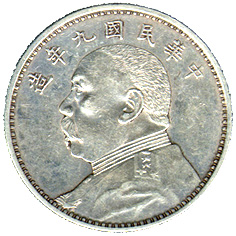 | 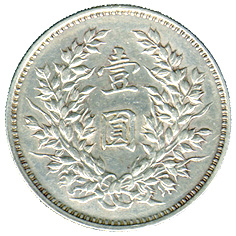 |
No. 204 |
| Diam. 39 mm | ||
| Wt. 26.8 g. | ||
| Mint Evolution and Peculiarity | Rareness E | |
| The inscriptions showing that this coin was minted in the 9th year of the Republic time (1920). [Actually, it may be minted later.] But it is very difficult for me to find out where this coin was produced; Wuchang, Tientsin, Kwangtung, or Hangchow, etc., Mints. I really don't know. I hope other more advanced collectors can help me. I have purchased this coin more than 10 years in Upper Lascar Row in Hong Kong. It cost me less than 6 US dollars. Now, it is pity that I can't buy coin from the coin hawkers directly in the flea markets. Coin hawkers purchase coins from Mainland China and then sell them to the dealers or collectors. If the hawkers firstly sell the coins to the collectors, they will earn more. Collectors prefer to purchase coins from hawkers as to get some more rare coins in cheap price. It is an offence to hawk without a licence in Hong Kong. For those unlicensed hawking in the street would be severely punished by a fine about HK dollars 400. (Old Hong Kong Government or The Government of the HKSAR would not issue licence to the hawker in the street.) If I want to purchase coins, I must pay more to get the coins from the coin shop now.
| ||
| Obverse | Reverse | Description |
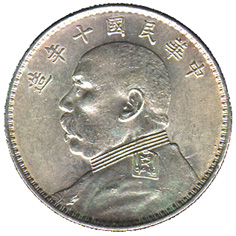 |
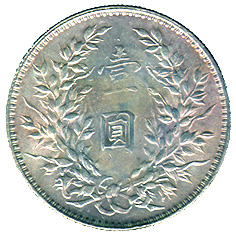 | No. 205 |
| Diam. 38 mm | ||
| Wt. 27 g. | ||
| Mint Evolution and Peculiarity | Rareness E | |
| This is another Yuan Shih Kai coin which was minted in 1921 or later. I paid almost double of the previous coin to buy it in a coin shop. This coin is in very good to fine condition with complete legend, value and on reverse with over-all wear but details of the flowers still visible. | ||
| Obverse | Reverse | Description |
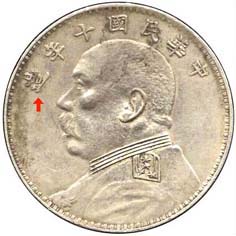 | 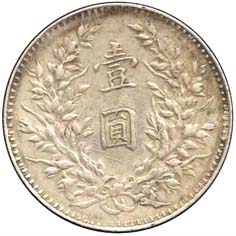 |
No. 335 |
| Diam. unknown | ||
| Wt. unknown. | ||
| Mint Evolution and Peculiarity | Rareness D | |
| This is one more version of the Yuan Shih Kai coin which was minted in 1921 or later. But, this one is very special for the variety of one of the Chinese character "Tsao" on the obverse. This version normally known as 連口造 "Lien-K'ou-Tsao" by the Chinese collectors. "Lien-K'ou-Tsao" in Chinese means "The mouth part 口 "K'ou" of the Chinese character 造 "Tsao" is jointed with the boat part 艇 "T'ing" of the Chinese character "Tsao". It may be more easy for you to understand as to view the coin image with a red arrow on the obverse. This version is not so common. This coin is belonged to Mr.我愛銀元, I am lucky to get his kind permission to post the coin images here. Thanks indeed! | ||
| Obverse | Reverse | Description |
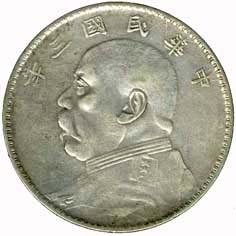 |
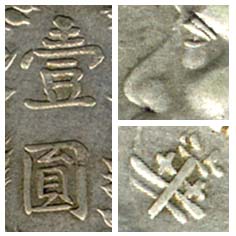 | No. 336 |
| Diam. 38 mm | ||
| Wt. 26.8 g. | ||
| Mint Evolution and Peculiarity | Rareness D | |
| As I know that there are many varieties of the Yuan Shih Kai coin, this is one more version of the Yuan Shih Kai coin which was minted by Kansu Mint in 1921 or later. It is known as 甘肅版 "Gansu Pan" (means made in Gansu Province). Kansu Pan normally appears with a bigger portrait. You can see the double-fold eyelid of Yuan's portrait and also the bold strokes of the Chinese characters on the reverse. Although Gansu coins circulated at a discount in the Repubic period for their low silver content, yet I am happy to get a copy of them. | ||
| Obverse | Reverse | Description |
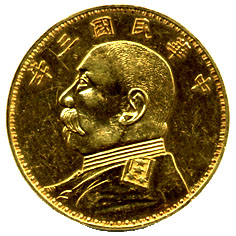 |
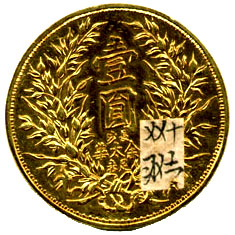 | No. 206 |
| Diam. 1.5 inch | ||
| Wt. ? g. | ||
| Mint Evolution and Peculiarity | Rareness ? | |
| As we know that gold as a noble metal of rare value has been treasured by the people of the world as an important means of storage and value preservation since ancient times. This is a gold coin. I received this image from Mr. SMT. His father left him the gold coin. On the reverse of this coin, there are 7 small Chinese characters denoted that this coin was minted with genuine gold by a goldsmith known as Yu Tai Wah in Changsha (The capital of Hunan Province) during the Republic period. The white label showing the characters in commercial Chinese numberal systems is 44.47 (mace or candareen??? I am not sure.). Although this coin was minted with excellent craftsmanship, coin like this was minted as presents for fame and compliments seeking, or merely as gifts to people. As this coin is a non-currency issue and minted with the noble metal, I think only very few were made. This coin should be quite rare today. As this is not a circulated coin, I hardly find any story it really shines. In my opinion, ancient coins are valuable because of their very real connection between us and the time period in which they were actively circulated.
| ||
| Obverse | Reverse | Description |
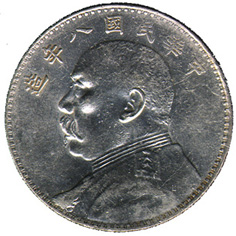 |
 | No. 206A |
| Diam. 18mm | ||
| Wt. 4.19g. | ||
| Mint Evolution and Peculiarity | Rareness A | |
| Yuan's Portrait Sample gold coin, minted in 3rd year of The Republic. Reference to: An Overview of China's Gold & Silver Coins of Past Ages by Mr. Dong Wenchao 1993, page 65. This coin was minted by the Tianjin Mint in 1914, or the 3rd year of the Republic. This is a trial-minted sample coin with a half-length side portrait of Yuan Shikai and the words "3rd year of the Republic of China" on the obverse and a dragon pattern on the reverse.
| ||